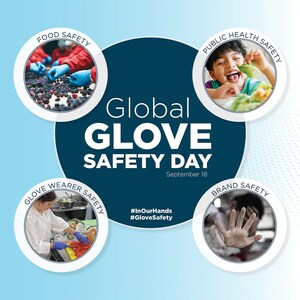LONG BEACH, Calif., July 18, 2024 /PRNewswire/ -- Over 100 billion disposable gloves are used in the United States every year and a good proportion of them contain chemical and microbial contaminants that are a threat to worker and public health. This is an issue urgently needing cleaning up, according to global protective glove suppliers Eagle Protect.
The research behind these claims is presented in a peer-reviewed article published this month in the International Association of Food Protection's Journal of Food Protection. This coincided with the Association's annual meeting this week that drew food science and safety professionals from around the world to Long Beach, CA to discuss these issues and more.
The paper "Potential for Glove Risk Amplification via Direct Physical, Chemical, and Microbiological Contamination" cites cheap toxic glove chemicals such as BPA, phthalates and PFAS contributing to potential health issues including carcinogenicity, endocrine disruption, fertility impairment, and skin diseases including dermatitis.
Microbial contamination of new, unused gloves including E. coli and Listeria from polluted water used in manufacture was reported, with 46 percent of imported gloves in the sample of 2,600 contaminated with traces of human fecal matter. The analysis highlights the need for more rigorous sourcing, validation, and quality testing to ensure gloves meet the highest safety standards before use. It emphasizes the importance of incorporating rigorous glove safety measures into hazard analysis and food safety programs to avoid contamination incidents.
Gloves are essential safety equipment used by millions of people daily in food handling, medical, law enforcement, industrial businesses, yet glove contamination is in urgent need of attention, says commissioning co-author Steve Ardagh, speaking from the IAFP conference.
Ardagh is founder of Eagle Protect, a protective glove supplier who has been campaigning for over a decade for greater awareness and action on an issue that he claims is "literally in our hands to solve."
"Glove manufacturing is loosely regulated, and current quality controls and verification of product performance standards are inadequate. Purchasers of protective gloves must insist on proof of safe ingredients, bioburden (microbial) testing standards, supply chain traceability, and the introduction of expiry dates."
According to food safety icon and Eagle Protect food safety consultant Dr. Darin Detwiler corporate, business, and institutional purchasers of gloves should educate themselves about glove safety and make informed decisions about what to place on the hands of their employees.
"Glove contamination is a massive blind spot in public health, and it needs to be cleaned up," says Dr. Detwiler, who featured in the Netflix documentary Poisoned: The Dirty Truth About Your Food.
Potential for Glove Risk Amplification via Direct Physical, Chemical, and Microbiological Contamination
Barry S. Michaels et al., Journal of Food Protection 87.7 (2024), https://doi.org/10.1016/j.jfp.2024.100283
Abstract: This review focuses on the potential direct physical, chemical, and microbiological contamination from disposable gloves when utilized in food environments, inclusive of the risks posed to food products as well as worker safety. Unrecognized problems endemic to glove manufacturing were magnified during the COVID-19 pandemic due to high demand, increased focus on PPE performance, availability, supply chain instability, and labor shortages.
Multiple evidence-based reports of contamination, toxicity, illness, deaths, and related regulatory action linked to contaminated gloves in food and healthcare, have highlighted problems indicative of systemic glove industry shortcomings. The glove manufacturing process was diagramed with sources and pathways of contamination identified, indicating weak points with documented occurrences detailed.
Numerous unsafe ingredients can introduce chemical contaminants, potentially posing risks to food and to glove users. Microbial hazards present significant challenges to overall glove safety as contaminants appear to be introduced via polluted water sources or flawed glove manufacturing processes, resulting in increased risks within food and healthcare environments. Frank and opportunistic pathogens along with food spoilage organisms can be introduced to foods and wearers. When the sources and pathways of glove borne contamination were explored, it was found that physical failures play a pivotal role in release of sweat build-up, liquefaction of chemical residues and incubation of microbial contaminants from hands and gloves.
Thus, with glove physical integrity issues, including punctures in new, unused gloves, that can develop into significant rips and tears, not only can direct physical food contamination occur, but chemical and microbiological contamination can find their way into food. Enhanced regulatory requirements for Acceptable Quality Limits of food grade gloves, and the establishment of appropriate bioburden standards would enhance safety in food applications. Based on information provided, together with a false sense of security associated with glove use, the unconditional belief in glove chemical and microbiological purity may be unfounded.
Media Contact: Katherine Har, SweeneyVesty USA, 79 Madison Avenue, New York, NY 10016
[email protected] tel. 917 275 7102
SOURCE Eagle Protect

WANT YOUR COMPANY'S NEWS FEATURED ON PRNEWSWIRE.COM?
Newsrooms &
Influencers
Digital Media
Outlets
Journalists
Opted In






Share this article